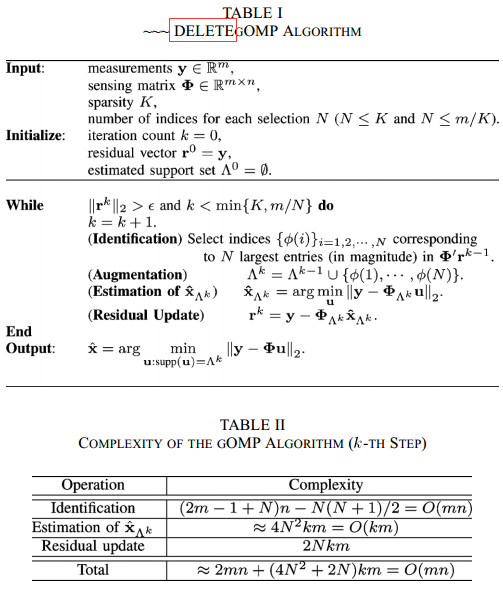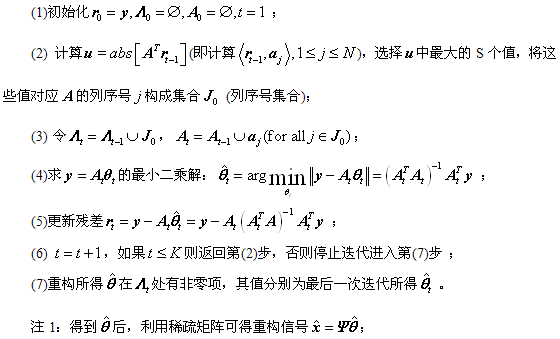广义正交匹配追踪(Generalized OMP, gOMP)算法可以看作为OMP算法的一种推广,由文献[1]提出,第1作者本硕为哈工大毕业,发表此论文时在Korea University攻读博士学位。OMP每次只选择与残差相关最大的一个,而gOMP则是简单地选择最大的S个。之所以这里表述为“简单地选择”是相比于ROMP之类算法的,不进行任何其它处理,只是选择最大的S个而已。
下图为论文中提出的算法伪代码流程:

1 gOMP重构算法流程


参考文献的代码如下所示:
(1)构造K稀疏信号
% Generate K-sparse vector
%
% N : original signal size.
% K : sparsity level
%
% Output parameters
% x_omp : estimated signal
% iter_count: iteration count during estimating
%
% Written by Suhyuk (Seokbeop) Kwon
% Information System Lab., Korea Univ.
% http://isl.korea.ac.kr
function [x x_pos] = islsp_GenSparseVec(N, K)
KPos = K;
if N/2 < K
KPos = N-K;
end
randPos = ceil(N*rand( KPos, 1 ));
randPos = union(randPos,randPos);
leftPOsLen = KPos-length(randPos);
while leftPOsLen > 0
tmpPos = ceil(N*rand( leftPOsLen, 1 ));
randPos = union(tmpPos,randPos);
leftPOsLen = KPos-length(randPos);
end
if KPos < K
randPos = setxor((1:N), randPos);
end
x = zeros( N, 1 );
x(randPos) = randn( K, 1 );
x_pos = randPos;
end
(2)gOMP函数
% Estimate the sparse signal x using generalized OMP
%
% y : observation
% Phi : sensing matrix
% K : sparsity
% S : selection length
%
% Output parameters
% x_omp : estimated signal
% iter_count: iteration count during estimating
%
% Written by Suhyuk (Seokbeop) Kwon
% Information System Lab., Korea Univ.
% http://isl.korea.ac.kr
function [x_ommp iter_count] = islsp_EstgOMP(y, Phi, K, S, zero_threshold)
% Check the parameters
if nargin < 3
error('islsp_EstgOMP : Input arguments y ,Phi and K must be specified.');
end
if nargin < 4
S = max(K/4, 1);
end
if nargin < 5
zero_threshold = 1e-6;
end
% Initialize the variables
[nRows nCols] = size(Phi);
x_ommp = zeros(size(Phi,2), 1);
residual_prev = y;
supp = [];
iter_count = 0;
while (norm(residual_prev) > zero_threshold && iter_count < K)
iter_count = iter_count+1;
[supp_mag supp_idx] = sort(abs(Phi'*residual_prev), 'descend');
supp_n = union(supp, supp_idx(1:S));
if (length(supp_n) ~= length(supp)) && (length(supp_n) < nRows )
x_hat = Phi(:,supp_n)y;
residual_prev = y - Phi(:,supp_n)*x_hat;
supp = supp_n;
else
break;
end
end
x_ommp(supp) = Phi(:,supp)y;
if nargout < 2
clear('iter_count');
end
end
(3)测试主函数
% Measurements size
m = 50;
% Signal size
N = 100;
% Sparsity level
K = 20;
% Generate sensing matrix
Phi = randn(m,N)/sqrt(m);
% Generate sparse vector
[x x_pos] = islsp_GenSparseVec(N, K);
y = Phi*x;
% Using default parameters
[x1 itr1] = islsp_EstgOMP(y, Phi, K);
% Find the sparse vector via selecting 4 indices
[x2 itr2] = islsp_EstgOMP(y, Phi, K, 4);
% Find the sparse vector via selecting 4 indices until the residual becomes 1e-12
[x3 itr3] = islsp_EstgOMP(y, Phi, K, 4, 1e-12);
disp('Mean square error');
[mse(x-x1) mse(x-x2) mse(x-x3)]
disp('Iteration number');
[itr1 itr2 itr3]
参考文献:
[1] Jian Wang, Seokbeop Kwon,Byonghyo Shim. Generalized orthogonal matching pursuit, IEEE Transactions on Signal Processing, vol. 60, no. 12, pp.6202-6216, Dec. 2012.
Available at: http://islab.snu.ac.kr/paper/tsp_gOMP.pdf
[2] http://islab.snu.ac.kr/paper/gOMP.zip